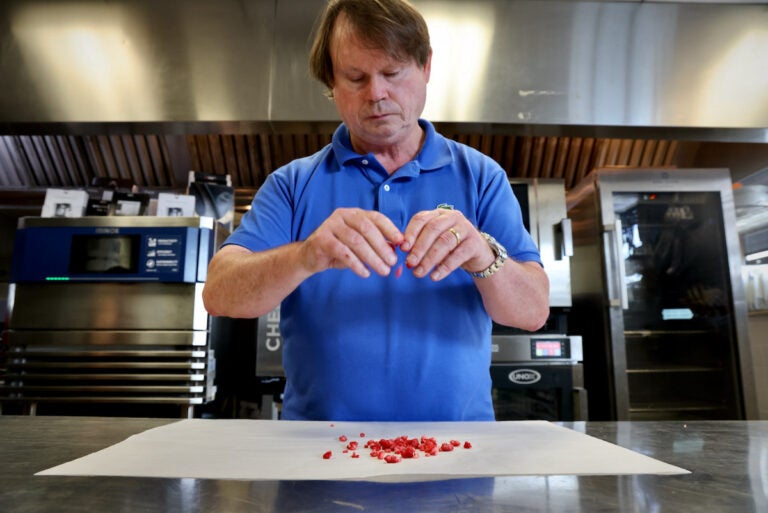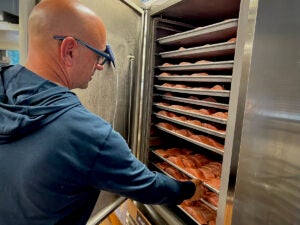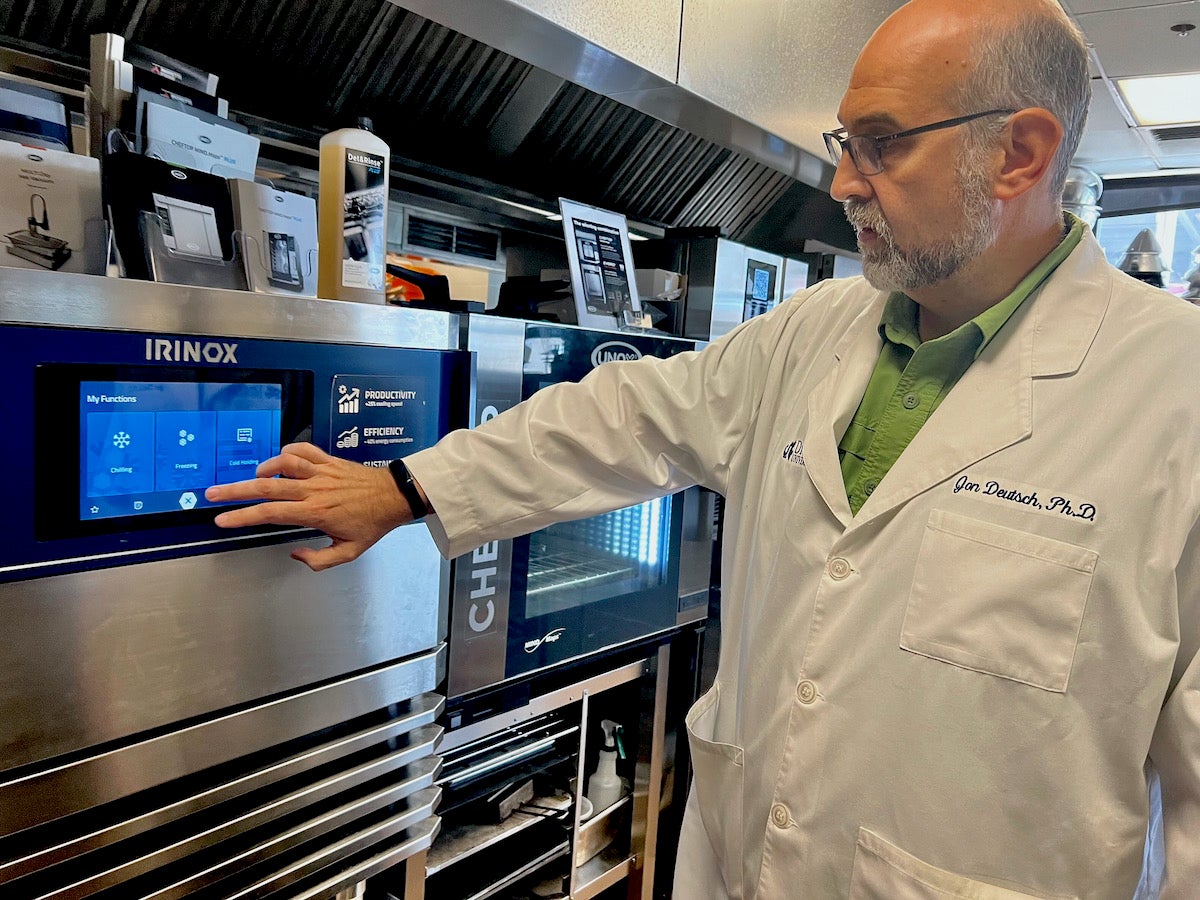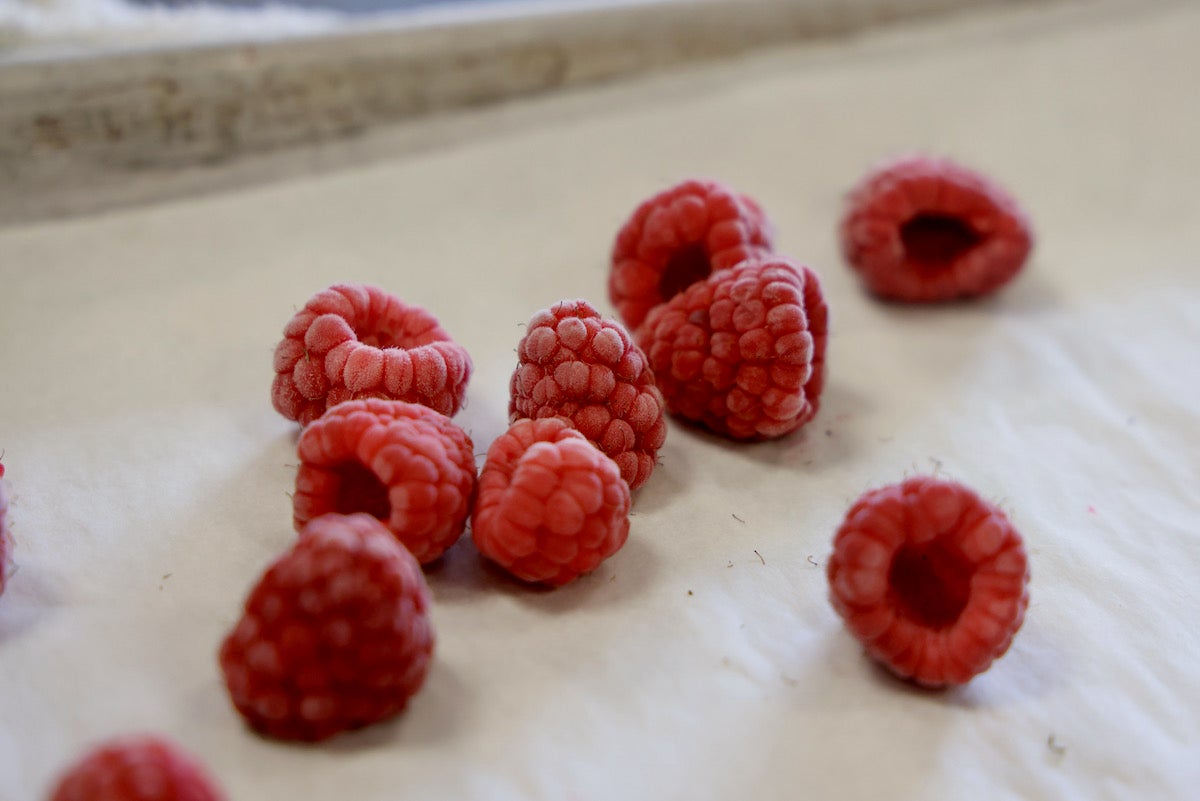Store owners use 'blast freezers' to improve food safety, quality, reduce waste
Blast freezers freeze food super fast and at very low temperatures, which ensures freshness, and cuts down on food waste.
Listen 6:35
Matt McKenney crumbles blast-frozen raspberries into the desert topping known as raspberry caviar. Blast freezing preserves the shape and texture of the delicate fruits in a way that ordinary freezing can't. (Emma Lee/WHYY)
This story is from The Pulse, a weekly health and science podcast.
Find it on Apple Podcasts, Spotify, or wherever you get your podcasts.
Robert Amar opened the door of one of his tall, stainless steel, blast freezers at his shop Small World Seafood in Philadelphia. A cold mist lingered over layers of trays carrying bright coral salmon filets.
“If you put your hands on those trays without gloves, it’s like putting your tongue on a pole,” Amar said. “You’ll get a little burn on your fingers. So you have to wear gloves to pull them out.”
He uses these exceptionally cold freezers for most of his seafood: from salmon to trout, from cod to scallops.

Amar said it ensures his products stay fresher over a longer time period. When customers buy fresh seafood at the market, they must cook the fish and eat it within a day. But his fish — frozen at temperatures much colder than a regular freezer — can be taken home and stored in a freezer for up to a year.
The seafood department is one of the most wasteful areas of the supermarket, studies show. When customers don’t buy fish before it spoils, staff must throw it away. Amar said using a blast freezer cuts down on waste.
“We’re not going to fix the problem. It’s a global issue. But you do what you can, right?” he said. “Everybody feels better about doing what they can. And it’s just a start.”
Amar also said his blast frozen fish tastes much better than regular frozen seafood.
“When your experience is only supermarket frozen fish, what are you going to think? ‘Frozen fish sucks,’” he said.
“If all you experience is buying bread in a supermarket, you think that’s what it is. But then, a French bakery opens up and you get a baguette, and you’re like, ‘Holy crap, this is what bread is supposed to taste like.’ Now you can’t go back. It’s that kind of thing. You just have to taste it and see it first before you can believe it.”
Subscribe to The Pulse
The fish must be blast frozen as soon as it’s in the shop to ensure quality, Amar added.
While a typical freezer stores food at 0°F, blast freezers can get as low as -30°F. They also freeze food much faster than a regular freezer, said Jonathan Deutsch, a culinary arts professor at Drexel University in Philadelphia.
“You probably experience that in your home — you put something in the freezer, and you check it an hour later and it’s cool to the touch, but it’s still not frozen solid,” he said. “And there’s nothing wrong with that. But from a food quality perspective, the quicker you freeze something, the better.”

In a blast freezer, Deutsch said, ice crystal formations are smaller, and don’t disrupt the cell wall structure of food. He said that process ensures the food product’s texture remains intact, and preserves the natural properties of the food — improving overall quality.
Most importantly, freezing food to lower temperatures at faster rates improves food safety, Deutsch said. Known as the “danger zone,” bacteria can double in number in as little as 20 minutes when food is between 40°F and 140°F.
“Food, whether you’re talking about fish, meat, fruit, vegetables, is really decaying tissue. It’s cut off from its life source and it’s deteriorating,” Deutsch said. “Sometimes we want to encourage that deterioration. If we’re cheesemaking or something, we want that aging process in that fermentation process to happen. And other times we want to prevent that. What freezing does is it really slows down those chemical and physical processes of that deterioration.”
He said this method of storing food is often preferable to the “fresh” seafood customers may see in grocery stores — a lot of which is previously frozen.
“They’re defrosted at the store because consumers have this idea that somehow refrigerated, quote-unquote fresh is somehow better than frozen,” he said. “And actually, the converse is true, that buying frozen seafood is better from a quality and a safety perspective.”
Blast freezers aren’t only used to store seafood. Pastry chefs use them to preserve the texture of their products, and some chefs use them so they can prepare food for the whole week, said Matt McKenney, who sells blast freezers to businesses and chefs across the Philadelphia region.
In a kitchen at Drexel University, McKenney freezes raspberries to demonstrate the power of blast freezing technology. When he takes the fruit out of the -30°F freezer, they’re hard like rocks.
“What we’re feeling is that the product is hard, but when you press it between your fingers, it crumbles. But it doesn’t crumble into mush,” McKenney said. “Each individual section and each little round segment of the raspberry is distinct.”
McKenney calls it “raspberry caviar.” No juices drip out of the raspberries.

Raspberries placed in a regular freezer lose the liquid that’s normally held in by those cell wall structures, he explained.
McKenney has experimented with blast freezers himself. During the pandemic, he co-founded a blast frozen pizza company called Pizza Freak Co. He said he doesn’t need to use preservatives for his pizza, and describes it as having restaurant quality taste. Customers who buy the blast frozen pizza can store it in their home freezer.
“We often refer to blast freezing food as freezing a moment in time. It’s not going to deteriorate past that,” McKenney said.
These blast freezers aren’t universal yet, however. They can cost thousands of dollars.
McKenney said they’re more common in Europe, which has stricter standards for frozen food.
WHYY is your source for fact-based, in-depth journalism and information. As a nonprofit organization, we rely on financial support from readers like you. Please give today.






